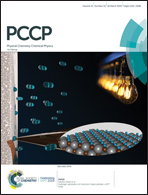Application of an inverse-design method to optimizing porphyrins in dye-sensitized solar cells†
Abstract
Dye-sensitized solar cells (DSSCs) have attracted much interest during the past few decades. However, it is still a tremendous challenge to identify organic molecules that give an optimal power conversion efficiency (PCE). Here, we apply our recently developed, inverse-design method for this issue with the special aim of identifying porphyrins with promisingly high PCE. It turns out that the calculations lead to the prediction of 15 new molecules with optimal performances and for which none so far has been studied. These porphyrin derivatives will in the near future be synthesized and subsequently tested experimentally. Our inverse-design approach, PooMa, is based on the strategy of providing suggestions for molecular systems with optimal properties. PooMa has been developed as a tool that requires minimal resources and, therefore, builds on various approximate methods. It uses genetic algorithm to screen thousands (or often more) of molecules. For each molecule, the density-functional tight-binding (DFTB) method is used for calculating the electronic properties. In the present work, five different electronic properties are determined, all of which are related to optical performance. Subsequently, a quantitative structure–property relationship (QSPR) model is constructed that can predict the PCE through those five electronic properties. Finally, we benchmark our results through more accurate DFT calculations that give further information on the predicted optimal molecules.



 Please wait while we load your content...
Please wait while we load your content...